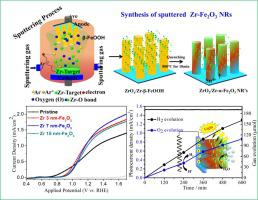Applied Surface Science ( IF 6.3 ) Pub Date : 2021-02-13 , DOI: 10.1016/j.apsusc.2021.149233 Haiqing Ma , Jun Beom Hwang , Weon Sik Chae , Hee Suk Chung , Sun Hee Choi , Mahadeo A. Mahadik , Hyun Hwi Lee , Jum Suk Jang

|
Synchronized surface modification and doping of hematite nanorod via sputtering is one of the impressive methods to develop photoanodes for practical application. In this paper, we report the role of Zr sputtering and 800 °C quenching on the structural and electrochemical properties of FeOOH NRs. The amount of ZrOx loading onto β-FeOOH NRs was controlled by varying the sputtering time. FESEM and TEM images revealed that high-temperature quenching of Zr-sputtered β-FeOOH NR’s confirms the Zr doping and non-uniform ZrO2 nanoparticles on vertically aligned Zr-doped hematite (Zr-Fe2O3 NRs). XPS analysis represented a tradeoff between extrinsic Zr doping and intrinsic Sn diffusion with increasing the thickness of deposited Zr layer in Zr-Fe2O3 NRs. A maximum achieved photocurrent density (1.23 mA/cm2 at 1.23 V vs RHE) for the 7 nm Zr-Fe2O3 sample is 48% higher than that of pristine photoanode (Fe2O3 NRs). The electrochemical impedance spectroscopy and Mott-Schottky analyses revealed that the charge transfer properties and donor densities were effectively improved for Zr-Fe2O3 NRs photoanode. The photoelectrochemical reactor consisted of an optimum 7 nm Zr-Fe2O3 based photoanode exhibits the 115 and 165 μmol, respectively O2 and H2 evolution over 10 h of 1 sun illumination. These results demonstrate the Zr sputtering approach followed by high-temperature quenching allows controlled Zr doping in vertically aligned Fe2O3 NRs for PEC water splitting applications.
中文翻译:

ZrO x /β-FeOOH纳米棒制备的Zr-Fe 2 O 3纳米棒光阳极的磁控溅射策略用于光电化学水分解
同步表面改性和通过溅射对赤铁矿纳米棒进行掺杂是开发用于实际应用的光阳极的令人印象深刻的方法之一。在本文中,我们报道了Zr溅射和800°C淬火对FeOOH NRs的结构和电化学性能的作用。通过改变溅射时间来控制加载到β-FeOOHNRs上的ZrO x的量。FESEM和TEM图像显示Zr溅射的β-FeOOHNR的高温淬灭证实了Zr掺杂的Zr掺杂赤铁矿(Zr-Fe 2 O 3)上的Zr掺杂和不均匀的ZrO 2纳米颗粒NRs)。XPS分析表示在非本征Zr掺杂和本征Sn扩散之间的权衡,这是随着Zr-Fe 2 O 3 NRs中沉积Zr层厚度的增加而实现的。7 nm Zr-Fe 2 O 3样品的最大实现光电流密度(1.23 V / RHE时为1.23 mA / cm 2,相对于RHE)比原始光电阳极(Fe 2 O 3 NRs)高48%。电化学阻抗谱和Mott-Schottky分析表明,Zr-Fe 2 O 3 NRs光电阳极的电荷转移性能和给体密度得到有效改善。光电化学反应器由最佳的7 nm Zr-Fe 2 O组成基于3的光阳极在1 h阳光照射下10 h分别表现出115和165μmol的O 2和H 2析出。这些结果表明,采用Zr溅射方法,然后进行高温淬火,可以在垂直排列的Fe 2 O 3 NRs中控制Zr掺杂,以用于PEC水分解应用。











































 京公网安备 11010802027423号
京公网安备 11010802027423号